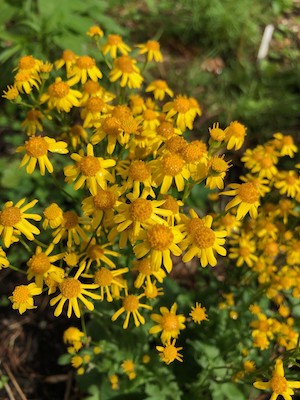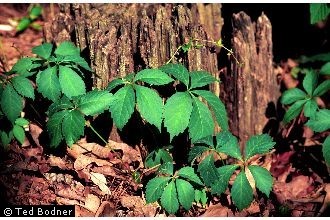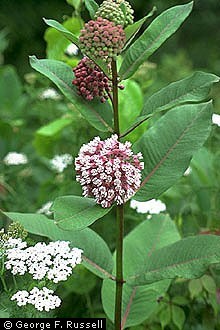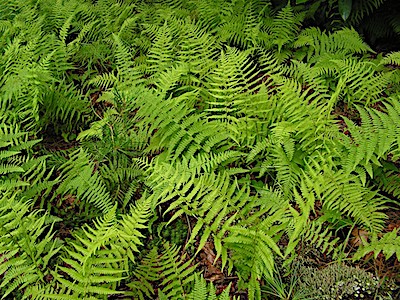When Native Plants Go Bad
By Brad Willet, Fairfax Master Gardener Intern

Golden Ragwort (Packera aurea)
The list of why we chose a particular plant can be endless. Some gardeners go out of their way to ensure each plant is provided its individual place, almost as if the garden bed is a vegetative trophy case. The display can be crowd pleasing, visually stunning and a showcase of taste and aesthetics. Native plants are great for these reasons as well as offering appropriate food to a variety of our winged friends — both birds and butterfly/moth species, abundance in nectar and pollen sources for our native generalist and specialist bee species, shelter and nesting material, stormwater remediation and erosion control. For all their benefits, there are some native plants that can be pernicious, aggressive spreaders, or even poisonous. Even under the best intentions native plants would be a welcome addition to any landscape — that is until they aren’t! Like that relative who overstays their welcome just a bit too long over family gatherings.
Many plant tags are developed for the consumer in mind and are provided the greatest marketing possible. That would include growing conditions. You may have the right plant for the right place, but how does that plant know that it has overstepped its bounds. It has strayed to your well-manicured hedge. It’s spilling over your paths. Oh, the horror!
The reality is that plants will respond to their environment in a myriad of ways. Native plants, ornamentals, herbs, vegetables — all have their way of telling you they are happy where they are growing or they are going to take up as much space as they can.

Virginia Creeper (Parthenocissus quinquefolia)
Some native plants have been known to be quite aggressive. They grow a little too well. Virginia creeper (Parthenocissus quinquefolia) is a great vining native plant. The vine climbs using tendrils and can grow low on the ground or vertical on trees or other plants and structures. The vine may grow up to 50 to 100 feet in ideal situations. It provides three season interest with its flowers, leaf color and berries. It is also a great forage food source for birds in winter and is also the host plant to a number of important sphinx moths, such as the Virginia creeper sphinx moth (Darapsa Myron). However, the plant may grow too abundantly for some gardener’s taste. Additionally, all parts of the plant are poisonous to humans.

Common milkweed (Asclepias syriaca)
Golden ragworts (Packera/Senecio aurea or obovata) are great defenders of the garden landscape. Prolific spreaders, they stay mostly evergreen from small rosettes that may turn a tint of purple in the winter. In the spring, stalks of bright yellow daisy-like flowers tower steadfast from the ground providing great early sources of nectar and pollen for emerging solitary bees and butterflies. When they are done flowering they can resemble tall dandelion puffs, which allow their seeds to be carried by wind or by a close passerby. They form dense colonies fairly quickly from either seed or stolons. Golden ragworts are also poisonous plants especially for any livestock, but usually are avoided unless forage sources are scarce.

Hay Scented Fern (Dennstaedtia punctilobula)
Some other “assertive” native plants are Virginia waterleaf (Hydrophyllum virginianum), wild petunia (Ruellia humilis), mountain mint (Pycnanthemum sp.), Bee balm (Monarda sp.) and Eupatorium species including blue mistflower (E. coelestinum), hyssop-leaved thoroughwort (E. hyssopifolium), common boneset (E. perfoliatum), and New York ironweed (Vernonia noveboracensis). They have great benefits to many native bee and pollinator species. Allowed to freely spread by either roots or seeds, these could be just what your landscape needed. By filling in barren areas, invasive prone spots, to outcompete allelopathic species, little by little these plants could add dynamic depth not yet considered.
Thug? I say welcome wingman in the battle against invasive exotics and other undesirable vegetation.
Landscaping choices have meaningful effects on the populations of birds and the insects they need to survive. The bottom line is this — homeowners, landscapers, and local policy makers can benefit birds and other wildlife by simply selecting native plants when making their landscaping decisions. No mowed edge, hardscape or container will contain a plant from doing what it wants to do. However, you hold a shovel in one hand, and your imagination in the other, and perhaps you can keep your strong-willed plants at bay or let them fill in an area so your battle isn’t with garlic mustard or Japanese knotweed, but what to plant next.
References
• Benefits of Native Plants, DCR Virginia
• Native, Invasive, and Other Plant-Related Definition, US Department of Agriculture Natural Resources
Conservation Service
• Common Milkweed, US Department of Agriculture Natural Resources Conservation Service